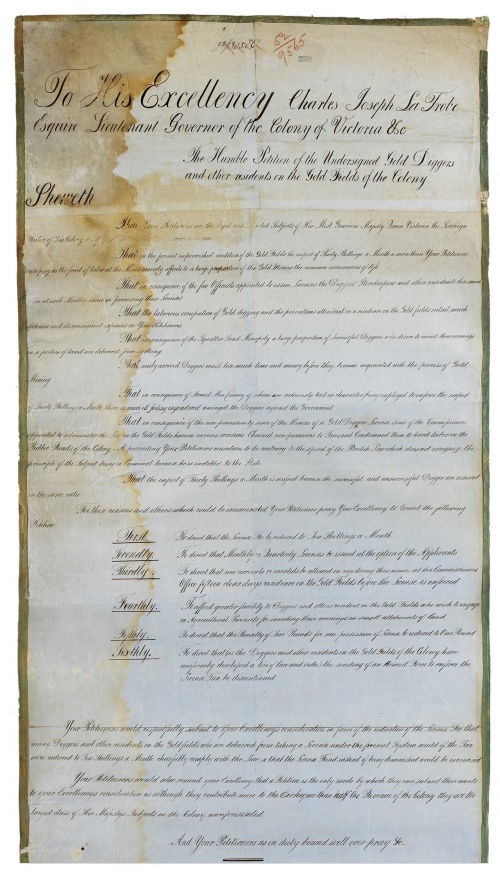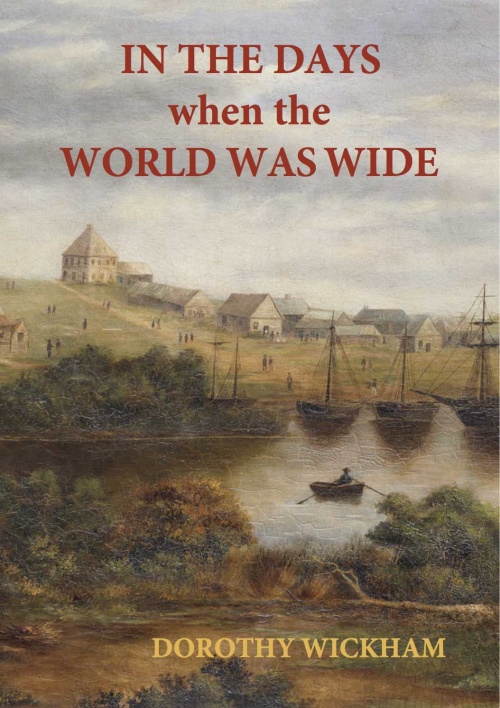Patrick Costello
Contents
Background
Ireland was in the grip of the Great Hunger in the 1840s and potatoes, the staple food, had been decimated. The large dependency on this single crop meant that tenant farmers and labourers struggled to feed families so that the death toll and disease was extremely high.
The experiences of Patrick Costello are typical of many who left Ireland under such extraordinarily difficult conditions. At least one million people are thought to have emigrated to America, Canada and Australia as a result of the famine. Men like Costello emigrated to far away places from homelands in the knowledge that they may never see loved ones again. They entered life in a new land with some misgivings but mostly enthusiasm and high expectations.
Costello’s narrative is significant, not only in terms of his emigration, but also because it is one of the few surviving records of pioneering experiences, with unique insights and detailed accounts of daily life, from someone who could neither read nor write. This narrative is important because so few accounts, letters or diaries of the working classes exist. Many immigrants could neither read nor write and so produced no written account of their pioneering lives.
Patrick Costello, an agricultural labourer, related his extraordinary pioneering experiences to a journalist, telling of his departure from Ireland, the beginning of a new life in the fledgling Port Phillip District of New South Wales in 1841, and his subsequent experiences of gold rushes and life till 1856. The narrative was published in 17 instalments in The Ballarat Courier from Saturday, 4 July 1896 to Saturday, 24 October 1896. The Courier publication contained two Parts VI and no Part XIII but this was corrected in the publication by Dorothy Wickham because it may cause confusion. Patrick’s experiences are chronologically narrated, with the exception of some interesting incidents such as an Aboriginal corroboree and a murder at Bendigo. Many facets of squatting life and Aboriginal culture are dealt with honestly and with humour.
This narrative, told by Costello, written by a journalist, and transcribed in In the Days, poses some interesting questions. Why was there no information about Costello’s family? Although his brothers and sisters, Myles (31), Walter (21), Mary (23) and Bridget (21) accompanied him on the Argyle they are not mentioned in his narrative. Even the brutal murder of his sister in 1851 by her husband, Patrick Kennedy, is not mentioned.[1] Did Patrick tell the journalist, who chose not to include it, or did he purposefully leave it out? Did he choose to concentrate more on details of events in his own life, rather than on personal matters relating to his family? The time factor may be another problem. Being serialized in the 1890s, has Costello embellished his stories, or even forgotten small incidents? It appears from my research that his memory is excellent, and the events are essentially accurate. The Courier reporter comments that Patrick is in excellent health in 1896.
Patrick Costello was born to Thomas and Ann on 4 March 1815 in Cong, Galway, Ireland. He was their third son, born on 4 March 1815. Walter had been born 12 years earlier in 1803, Myles in 1810, then Patrick, and after him a daughter, Mary born 1818, Francis 1820, and Bridget in 1821. Little is known of their life in west coast Ireland between 1800 and 1840.
Patrick travelled to Liverpool where he embarked on his journey with his siblings. He gives a first-hand account of the voyage from Liverpool relating experiences with pirates and life on board the vessel. On arriving as a bounty immigrant in Port Phillip, Patrick he was employed by Captain Hepburn who owned Smeaton Station. The first night spent in Australia was near Captain Hutton’s at Flemington ‘without fire, supper, or bedding of any kind’.
Patrick’s sisters, Mary and Bridget Costello, both married at St Francis Church in Melbourne on the same day, 30 April 1843. Bridget married Henry Johnson while Mary married Patrick Kennedy, an Irishman from Kiltullagh, Galway who was attended by his shipmate Denis Kinnane, also from the same Townland. Five years later, on 2 July 1848, Patrick married Ann Clarke at the same church.
Ann had been a fellow passenger in 1841 on the Argyle. Born in Kildare, Ireland, she was travelling with her parents. James Clarke, her father, also worked for the Hepburn’s at Smeaton.
Costello spent some time in Melbourne as a water-carter and a hay and corn merchant. He built up a substantial business in Melbourne before 1850 and at one time owned a considerable portion of Collins Street, which he eventually sold for £1,000.
Patrick and Ann faced many disappointments and hardships. While they were in Melbourne twin boys, John and Miles, were born and died in 1850. The Costello’s then went to the Bendigo gold fields where Patrick (junior) was born on 7 April 1853. Patrick relates his experiences as a “digger” with all the excitement and fervour that the rushes produced. He tells of the hunting for gold licences, the “rush” to new claims, the thrill of finding gold, that “could be seen” ... “like raisins in a pudding”.[2]
Researched and written by Dorothy Wickham.
Goldfields Involvement, 1853-1854
Signed the 1853 Bendigo Goldfields Petition. Agitation of the Victorian goldfields started with the Forest Creek Monster Meeting in 1851, but what became known as the Red Ribbon Movement was centred around the Bendigo goldfields in 1853. The Anti-Gold License Association was formed at Bendigo in June 1853, led by George Thomson, Dr D.G. Jones and 'Captain' Edward Browne. The association focused its attention on the 30 shillings monthly licence fee miners were required to pay to the government. They drew up a petition outlining digger grievances and called for a reduced licence fee, improved law and order, the right to vote and the right to buy land. The petition was signed by diggers at Bendigo, Ballarat, Castlemaine, McIvor (Heathcote), Mount Alexander (Harcourt) and other diggings. The 13 metre long petition was presented to Lieutenant-Governor Charles La Trobe in Melbourne on the 01 August 1853, but their call for a reduction in monthly licence fees and land reform for diggers was rejected. The diggers dissatisfaction erupted into the Red Ribbon Rebellion where agitators wore red ribbons on their hats symbolising their defiance of the law and prohibitive licence fees.
Post 1854 Experiences
By 1862 the family had settled at Cabbage Tree (Creswick) where Emily Ann was born in December 1862. Tragedy struck again and Emily Ann died, aged only two months. It appears they stayed in North Creswick where the next three children were born: Henrietta in 1864; Emily Elizabeth in 1869; and Alice Louisa in 1872. Sadness visited once again with Emily Elizabeth dying at one year of age.
Ann Costello (Clark) died at Creswick on 28 August 1882. Patrick Costello died at the Creswick hospital from senile decay on 22 January 1907. He had been a colonist for over 70 years. Ann and Patrick are buried at Creswick Cemetery along with their children Herbert Howard, Alice, Emily Ann, Emily Elizabeth, and Patrick Edward.
See also
Ballarat Reform League Inc. Monuments Project
Further Reading
References
- ↑ Wickham, "And God Almighty have Mercy on his Soul", Central Highlands Historical Association Journal, Volume 5, p. 21; Christina Twoomey,‘Nasty talk: anatomy of the first wife murder in the new colony of Victoria’, Provenance: The Journal of Public Record Office Victoria, issue no. 19, 2021.
- ↑ Dorothy Wickham, In the Days when the World was Wide, 1996, Republished in ePub form by BHS Publishing 2020.
External links
If you can assist with information on this person, or a related image, please email eurekapedia@yahoo.com.au
To CITE this page click Cite This Page on the link to the left of this page.
Further Reading
References
External links
If you can assist with information on this person, or a related image, please email eurekapedia@yahoo.com.au
To CITE this page click Cite This Page on the link to the left of this page.

